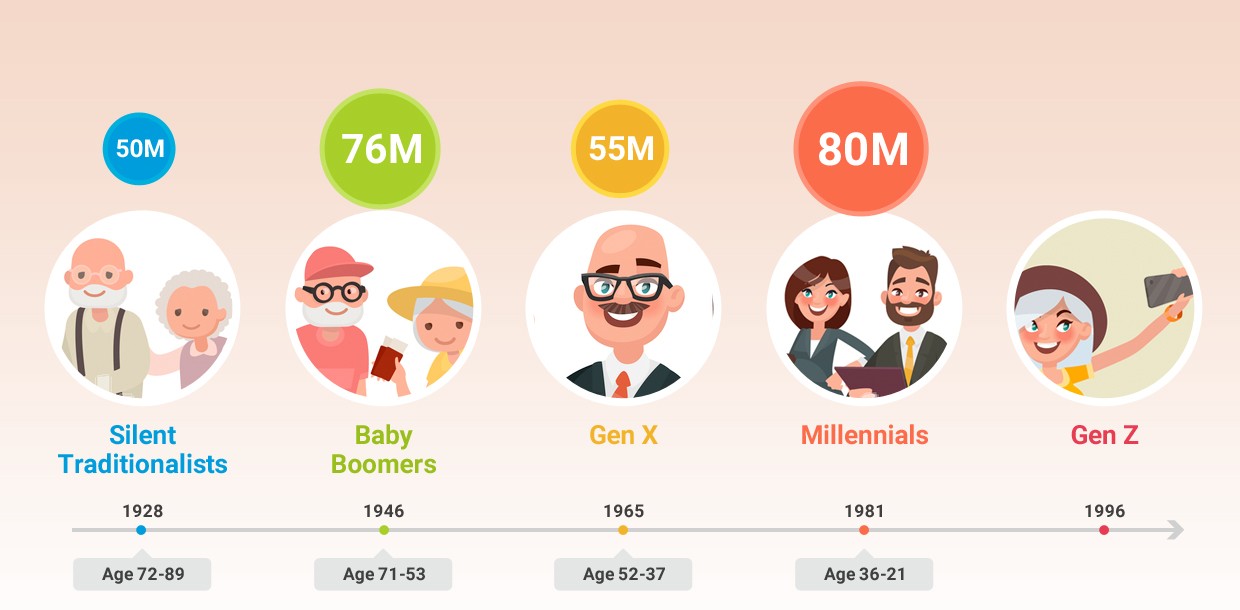
Understanding What to Build to Different Generations
While it may be fun to poke fun at millennials and blame us for killing the napkin industry, the truth is understanding how each generation thinks has become a key component in building products.
Traditionalists or the Silent Generation (1945 and earlier)
The oldest living generation is often described as conservative, hard-working and resilient. They grew up in a time of crisis as their lives were heavily influenced by the Great Depression and both World Wars. Just like their label-they are quite traditional, meaning they’re not interested in any kind of flashy, high-tech advertising tactics.
These are the people who still wake up every day and actually read the newspaper. While some would say this group has become a niche demographic; the fact is they still have purchasing power and thus must be accounted for when strategizing concepts.
Baby Boomers (1946-1964)
Also known as the “me” generations, these are the people who are slowly starting to embrace the digital age but still appreciate a good voicemail or face-to-face conversation. Although millennials are on track to surpass Baby Boomers as the largest generation in the next few years, baby boomers continue to have the most purchasing power.
They’re heading into retirement and tend to have significantly higher disposable incomes compared to millennials, many of whom are bogged down by debt. This demographic spends the most across all product categories, yet are targeted by just five to ten percent of new product builders. If businesses took advantage of putting effort and funds into capturing this group’s attention, they would be poised to emerge as a market leader.
Generation X (1965-1980)
Of all the groups, Gen X is continually the hardest to categorize. Sandwiched between two larger generations that are vastly different from one another; millennials and baby boomers, Gen Xers can often be overlooked.
They aren’t worried about themselves or what makes them special, they’re concerned about their young children and securing their futures. For this reason, products targeted toward Gen X should be less about them and their needs or wants and more about promoting stable family life.
Millennials (1981-1995)
Ah yes, the “special snowflakes” that everyone else seem to love to hate so much. Millennials are known for having a sense of entitlement, something instilled in us by our baby boomer parents and a lifetime’s supply of participation trophies.
Bad reputation aside, they are also an emerging opportunity for marketers that businesses can’t afford to ignore. Millennials possess a collective $600 billion in purchasing power each year. Millennials are also motivated by recommendations from family and friends and they are also attracted to easy shopping, i.e. online shopping. When making a purchasing decision millennials look to reviews from other customers and will do anything for free shipping. All advertising, marketing campaigns and product development should also always be optimized for mobile viewing as 52% of millennials use smartphones for shopping and browsing.
Generation Z (1996 and later)
Millennials may be very tech savvy, but it’s nothing compared to this digital generation. They were born into an age where they cannot even imagine life without a cell phone, let alone without Wi-Fi.
The most socially conscious and diverse generation, they also are more inclined to interact with companies they believe in. With Snapchat, Instagram and Twitter quite literally at their fingertips, they will be quick to judge a company’s authenticity based on their social media presence. They have an average "eight-second filter" to gauge whether something is worth their attention. The youngest generation also tends to gravitate toward getting information quickly without having to actually speak to anyone, think short explainer videos and social media campaigns.
At the end of the day, it’s important to remember that not all products are created equally and what may resonate with one person could offend another. The best way to combat this is to understand the different demographics and make educated decisions in your marketing campaigns and product development.
Writer, Editor & Communications Specialist for Creatives, Modern Businesses + SaaS Companies who serve them too. Fueled by hot chocolate ☕ | SPEAKER | EDUCATOR
3yThis is fantastic! And so helpful! I think understanding how each generation thinks is not only important in building products but marketing them as well. As a Copywriter, I've realised that the target audience and their thinking process plays a huge role in defining the voice and tone of a brand, so writers can create copy that connects.
Director | Founder | Consultant | Included VC Fellow (Class '22)
3yThanks for the article Fathhi Mohamed! Interesting to note the differences in how people consume and process information across generations. How does the way a person consumes information (or marketing content) change as they get older? Curious to know if there is any connection to the generational differences.